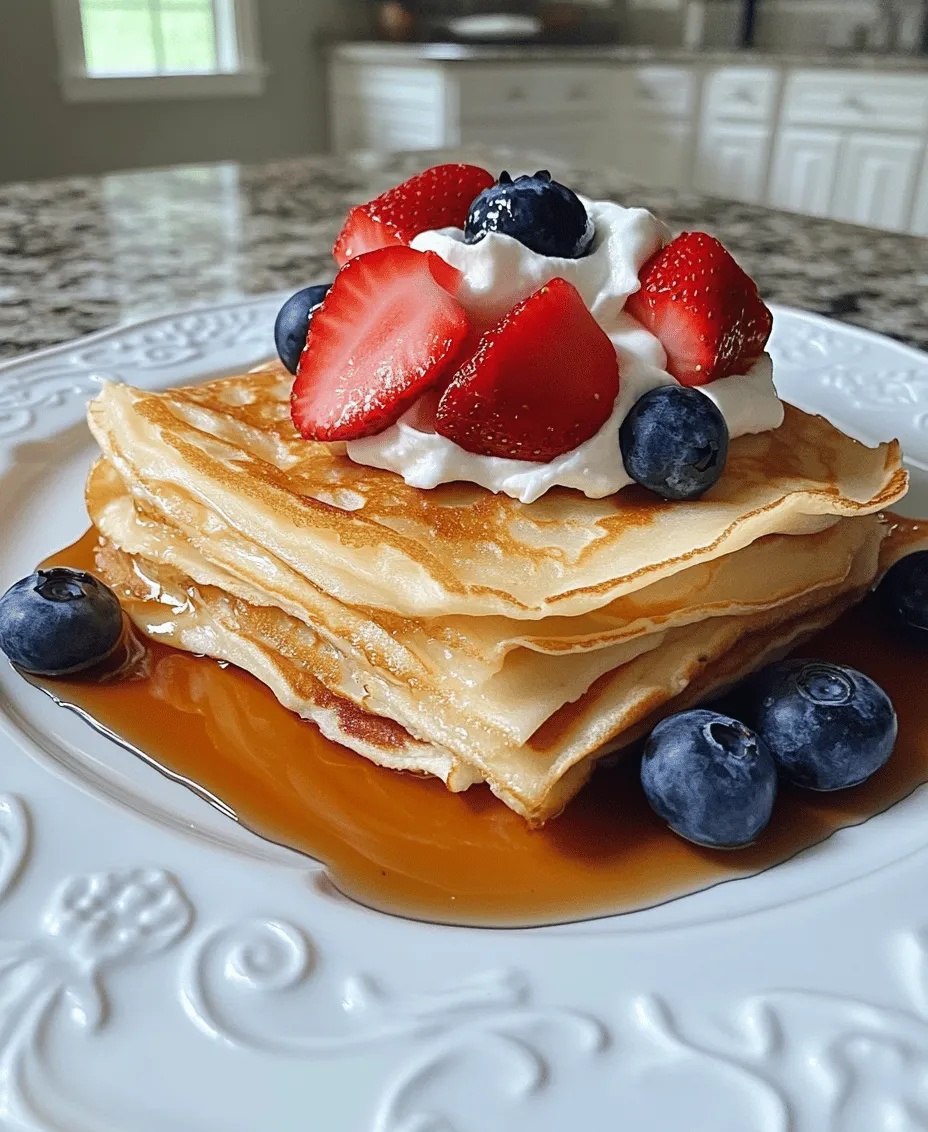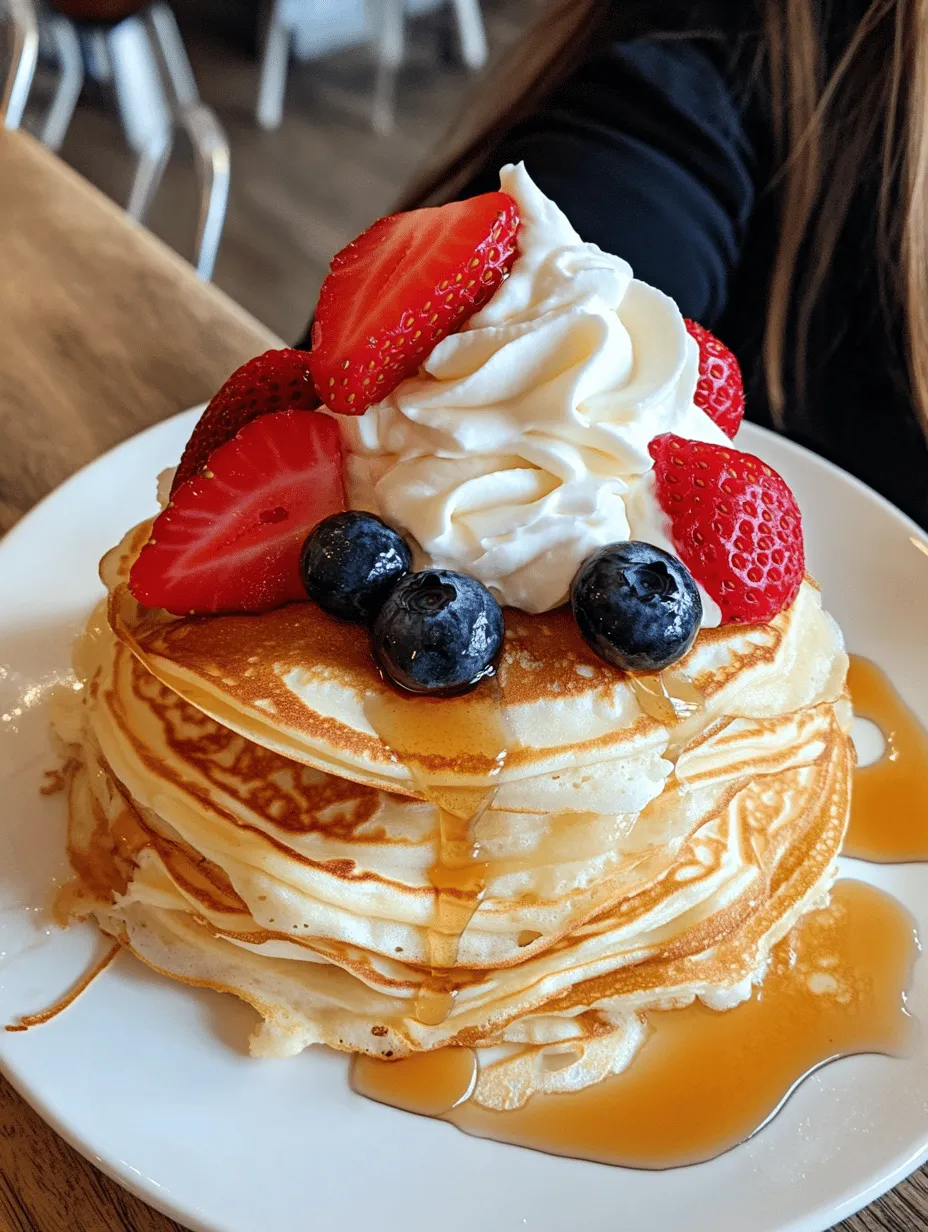Introduction
Crepes are a delightful culinary creation that has captured the hearts—and appetites—of food lovers around the globe. Originating from France, these thin pancakes are incredibly versatile, making them suitable for both sweet and savory dishes. Whether filled with fruits, whipped cream, or even savory ingredients like cheese and ham, crepes offer endless possibilities that cater to a wide range of tastes and preferences. In particular, vanilla crepes evoke a sense of comfort and indulgence, serving as a beloved option for breakfast or dessert.
What makes vanilla crepes truly special is their simplicity. With just a handful of common ingredients, this recipe allows you to create a deliciously light and airy treat right in the comfort of your own kitchen. The fragrant aroma of vanilla wafting through your home as they cook is guaranteed to tempt anyone nearby. Whether you’re looking to impress guests at brunch or treat yourself to a cozy evening dessert, these heavenly vanilla crepes are sure to become a staple in your culinary repertoire.
Understanding Crepes: A Culinary Perspective
Crepes are defined as thin pancakes made from a batter of flour, eggs, and milk, cooked on a flat surface or skillet. Their roots can be traced back to Brittany, a region in north-western France, where they were originally made with buckwheat flour and served as a savory dish. Over time, crepes evolved to include a variety of ingredients, leading to the two primary types we see today: sweet and savory.
Sweet crepes are often enjoyed as a dessert or breakfast option, filled with ingredients such as fresh fruits, whipped cream, chocolate, or syrups. Vanilla crepes fall squarely into this category, bringing a delightful sweetness and rich flavor profile that can be enhanced with various toppings. On the other hand, savory crepes are typically filled with ingredients like meats, cheeses, and vegetables, making them a hearty meal option.
Culturally, crepes hold significant importance in French cuisine and are often associated with celebrations and festive occasions. The technique of making crepes is paramount to achieving the perfect texture: they should be thin, delicate, and slightly chewy, yet soft enough to fold without tearing. Mastering the art of crepe-making requires practice, but with the right guidance, anyone can create a batch of mouthwatering crepes that will impress family and friends.
Ingredients Breakdown
To create heavenly vanilla crepes, you will need a few fundamental ingredients, each playing a crucial role in the overall outcome of the dish. Here’s a detailed breakdown of each ingredient and its significance:
– All-Purpose Flour: This is the foundation of the crepe batter, providing the necessary structure and texture. All-purpose flour is ideal for crepes due to its moderate protein content, which helps achieve the desired thinness and flexibility.
– Eggs: Eggs contribute richness and structure to the crepes. They help bind the ingredients together, ensuring that the batter holds its shape when cooked. Additionally, eggs add a subtle flavor, enhancing the overall taste of the crepes.
– Milk: Milk is essential for achieving the right consistency in the batter. It hydrates the flour, creating a smooth mixture that can be easily spread in a thin layer on the cooking surface. The fat content in milk also contributes to the tenderness of the finished crepes.
– Granulated Sugar: A small amount of sugar adds sweetness to the batter, balancing the flavors. While the sugar is optional, it enhances the overall taste of the crepes, especially when paired with sweet fillings.
– Vanilla Extract: This ingredient is what sets vanilla crepes apart from regular ones. Vanilla extract infuses the batter with a delightful aroma and flavor that elevates the entire crepe experience. Using pure vanilla extract is highly recommended for the best results.
– Melted Butter: Butter adds richness and flavor, making the crepes more indulgent. It also helps prevent the crepes from sticking to the pan, ensuring a smooth cooking process. Be sure to let the butter cool slightly before adding it to the batter to avoid cooking the eggs.
– Salt: A pinch of salt is essential for balancing flavors. It enhances the sweetness and overall taste of the crepes, making every bite delightful.
In addition to these core ingredients, there are plenty of optional toppings that can further enhance your experience. Fresh fruits like strawberries, bananas, or blueberries make excellent choices, providing a burst of freshness and flavor. Whipped cream, chocolate sauce, or even a drizzle of maple syrup can add an extra layer of decadence. The versatility of vanilla crepes allows for endless variations, ensuring there’s something for everyone to enjoy.
Step-by-Step Instructions
Now that we’ve covered the ingredients, it’s time to dive into the step-by-step instructions for preparing the crepe batter. Follow these clear and detailed steps to ensure your vanilla crepes turn out perfectly every time.
1. Prepare the Batter: Begin by gathering all your ingredients. In a large mixing bowl, combine 1 cup of all-purpose flour, 2 large eggs, and a pinch of salt. Using a whisk, beat the eggs into the flour until well combined.
2. Incorporate the Milk: Gradually pour in 1 1/2 cups of milk while continuing to whisk the mixture. This step is crucial for achieving a smooth batter; add the milk slowly to prevent lumps from forming. Continue whisking until the batter is completely smooth and well combined.
3. Add Sugar and Vanilla: Next, add 1 tablespoon of granulated sugar and 1 teaspoon of pure vanilla extract to the batter. Whisk again to ensure that the sugar and vanilla are evenly distributed throughout the mixture.
4. Melt the Butter: In a small microwave-safe bowl, melt 2 tablespoons of butter. Allow it to cool slightly before incorporating it into the batter. This step is important for preventing the eggs from cooking prematurely.
5. Combine the Ingredients: Once the butter has cooled, pour it into the batter and whisk until fully combined. The batter should be smooth and slightly runny, resembling heavy cream.
6. Rest the Batter: For the best results, let the batter rest for at least 30 minutes at room temperature. This resting period allows the flour to fully hydrate, resulting in more tender crepes.
7. Preheat the Pan: While the batter rests, preheat a non-stick skillet or crepe pan over medium heat. You can lightly grease the pan with a small amount of butter or oil, but be cautious not to overdo it, as too much grease can lead to oily crepes.
8. Cook the Crepes: Once the pan is hot, pour about 1/4 cup of batter onto the center of the pan. Quickly swirl the pan to spread the batter into a thin, even layer. Cook for about 1-2 minutes, or until the edges begin to lift and the surface appears set. Carefully flip the crepe using a spatula and cook for an additional 30 seconds to 1 minute on the other side.
By following these initial steps, you’ll be well on your way to creating deliciously light and fluffy vanilla crepes that are perfect for any occasion. As you master the technique, feel free to experiment with different fillings and toppings to make the recipe your own.

Heavenly Vanilla Crepes: Cooking and Serving Guide
The Importance of Allowing the Batter to Rest
One crucial step that can significantly enhance the texture of your crepes is allowing the batter to rest. This resting period, ideally around 30 minutes to an hour, allows the flour to hydrate fully and the gluten to relax. As a result, you’ll achieve a tender, delicate crepe that is less likely to tear during cooking. Additionally, resting the batter helps reduce air bubbles, leading to a smoother texture. For the best crepe experience, don’t rush this step; it’s worth the wait.
Comprehensive Guide on Cooking the Crepes
Temperature Control and Pan Preparation for Optimal Results
When it comes to cooking crepes, the right temperature and pan preparation are essential. Use a non-stick skillet or a crepe pan for best results. Preheat your pan over medium heat; too high a temperature can cause the crepes to cook unevenly and burn, while too low a temperature might result in crepes that are pale and undercooked.
Once your pan is hot, it’s crucial to grease it lightly with butter. A paper towel can help spread a thin layer evenly. This not only prevents sticking but also adds flavor. If you’re using a seasoned non-stick pan, you may find that minimal grease is required.
Cooking Steps
1. Pour the Batter: Use a ladle to pour a small amount of the batter into the center of the hot pan. Immediately tilt and swirl the pan to spread the batter evenly, forming a thin layer.
2. Cooking Time: Allow the crepe to cook for about 1-2 minutes. You’ll know it’s time to flip when the edges start to lift slightly and the surface appears dry, with only a few bubbles forming.
3. Flipping the Crepe: Gently slide a spatula under the crepe, lifting it carefully. Flip it over in one smooth motion. Cook for an additional 30 seconds to 1 minute until the other side is lightly golden.
4. Stack and Keep Warm: Once cooked, transfer the crepe to a plate and cover it with a kitchen towel to keep warm. Repeat the process, greasing the pan lightly if necessary between crepes.
Visual Cues for Knowing When to Flip the Crepes
Learning to recognize visual cues is key to mastering the art of crepe-making. Look for the following signs:
– Edges Lifting: As the crepe cooks, the edges will start lifting from the pan, indicating it’s ready to flip.
– Surface Drying: The batter should appear dry and no longer glossy as it cooks. This is a good sign that the crepe is set and can be flipped.
– Bubbles Forming: Small bubbles will form on the surface of the crepe, signaling that cooking is progressing.
By paying attention to these cues, you can achieve perfectly cooked crepes every time.
Serving Suggestions and Pairings
Crepes are incredibly versatile and can be served in various ways. Here are some creative ideas to elevate your crepe experience:
Fresh Berries
Fresh berries like strawberries, blueberries, or raspberries provide a burst of freshness and color that contrast beautifully against the delicate crepe. They also add a natural sweetness and a dose of antioxidants, making them a healthy topping choice.
Whipped Cream
Adding a dollop of whipped cream introduces a light, airy texture that complements the tender crepes perfectly. You can make your own whipped cream or use store-bought for convenience. For an extra touch of flavor, consider infusing your whipped cream with vanilla or a hint of almond extract.
Maple Syrup
A drizzle of pure maple syrup adds a classic sweet touch to your crepes. The rich, caramel-like flavor works harmoniously with the vanilla, enhancing the overall taste. For a twist, warm the syrup slightly before serving, allowing it to soak into the crepes.
Nutella
For chocolate lovers, Nutella is a must-try filling. Spread a generous layer inside the crepe and fold it over. The creamy, chocolate-hazelnut spread melts beautifully with the warm crepe, creating a decadent treat that’s hard to resist.
Personalizing Your Crepes
Encourage creativity by suggesting different flavor combinations. For example, you can add sliced bananas and a sprinkle of cinnamon for a delightful twist. Alternatively, try cream cheese with a hint of lemon zest for a tangy contrast. The possibilities are endless, making each crepe experience unique.
Nutritional Information
Understanding the nutritional aspects of your crepes can help you enjoy them as part of a balanced diet. Here’s a quick overview of the nutritional benefits of the ingredients typically used:
– Flour: Provides essential carbohydrates for energy. Whole wheat flour can be used for a higher fiber content.
– Eggs: A great source of protein, essential vitamins, and minerals, contributing to a feeling of fullness.
– Milk: Offers calcium and Vitamin D, vital for bone health.
– Butter: Adds flavor and richness, but can be used sparingly to reduce saturated fat intake.
Portion Sizes
Crepes can fit into a balanced diet when enjoyed in moderation. A typical serving consists of one or two crepes filled with your favorite toppings. Be mindful of portion sizes, especially when using high-calorie toppings like whipped cream or Nutella. Pairing crepes with fresh fruits can enhance their nutritional value while keeping the meal light and satisfying.
Common Mistakes to Avoid
Even the most seasoned cooks can encounter pitfalls when making crepes. Here are some common mistakes and how to avoid them:
Overmixing the Batter
While it’s important to combine your ingredients, overmixing can lead to tough crepes due to the development of gluten. Mix just until the ingredients are combined and no lumps remain. Allowing the batter to rest will also help alleviate any remaining lumps.
Cooking at Too High a Temperature
If your pan is too hot, the crepes can burn on the edges while remaining undercooked in the center. Maintain a medium heat and adjust as necessary. A good test is to sprinkle a few drops of water onto the pan; if they sizzle and evaporate quickly, the temperature is just right.
Not Using Enough Butter
Crepes are prone to sticking if the pan isn’t sufficiently greased. Use a small amount of butter each time you pour in the batter. If you notice sticking, add a little more butter to the pan before the next crepe.
Conclusion
Making homemade vanilla crepes is a delightful experience that brings joy to both the cook and those who enjoy the finished dish. Their tender texture and versatility make them a perfect canvas for a wide range of toppings and fillings. Whether you prefer fresh fruits, sweet sauces, or rich spreads, there’s a combination for everyone.
Don’t hesitate to experiment with different flavors and toppings to create a personalized crepe experience that suits your taste. As you perfect your technique and explore new ingredients, you’ll discover the timeless appeal of crepes as a comforting and satisfying dish suitable for any meal of the day. Enjoy the journey of creating these heavenly delights, and share them with family and friends for a truly memorable experience.



